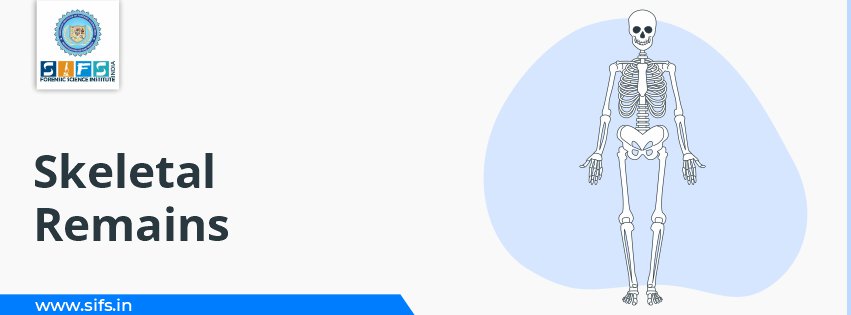- Call Us: +91 7303913002
- Email Us: education@sifs.in
Skeletal Remains Significance in Forensic Science

BY SIFS India | January 04, 2023
Skeletal Remains Significance in Forensic Science
Human remains or skeletal remains refer not only to a complete skeleton but also include a part of a bone or tooth, hair and mummified remains.
Human remains are present in different places such as
1. Archaeological burial sites ( individual/mass graves)
2. Fire scenes
3. Natural disasters
4. Open areas (woodlands)
5. Graves
Human skeletal remains are studied to reconstruct crimes and to provide important information about the deceased such as their sex, age, stature etc.
SIGNIFICANCE OF SKELETAL REMAINS
An anthropologist studies skeletal remains by using different techniques and methods.
● The growth along with the development of bones and teeth provide an idea about the age of the individual.
● Shape of the pelvis bone helps in the determination of the sex of an individual
● Abnormal changes in the size or shape or even density of bones may indicate disease and trauma.
● Premortem injuries in bones such as fractures, bullet holes etc may help in determination of the cause of death.
● Even occupation and other activities can be analysed on the basis of skeletal remains, especially teeth.
DETERMINING THE HEIGHT OF AN INDIVIDUAL STATURE
A forensic expert can indicate an individual’s height by analysing long bones of the body such as the femur, tibia, humerus and radius.
A significant difference in the bones of males and females helps a forensic expert to distinguish between the genders. Further, both men and women have different proportions of long bones based on their total height, so different formulas have been developed by scientists to study these. The following formulas estimate height in the range of 7.5 cm.
FEMALES -
1. Height = femur length*2.21 + 61.41
2. Height = length of tibia*2.53 + 72.57
3. Height = length of radius*3.87+ 73.50
4. Height = length of humerus*3.14+ 64.97
MALES -
1. H = Femur length*2.23+ 69.08
2. H = Tibia length*2.39+ 81.68
3. H = Humeruslength*2.97+73.57
4. H = Radius length*3.65 + 80.40
SEX DETERMINATION
Sex determination is a crucial process in case of unidentified human remains.
Different parts of pelvis such as os pubis, sacrum & ilium have major differences in males and females.
Apart from the pelvis bones, the shape of skull, shape of mandible jaw and the size of occipital protuberance (bump) at the backside of skull also helps in sex determination.
The most common way of determining the sex is by -
1. Observe the size of the bones as males have larger bones in comparison to females.
2. Men also tend to have larger attachment of muscles.
3. Shape of sacrum is straighter in females and males have a curved sacrum.
4. The middle space in pelvic bones is larger in females for easier birth delivery whereas middle space in pelvic bones is less.

Figure 1 - Male and Female Pelvic Bone
5. For surest determination of sex, a forensic anthropologist must determine three basic features of the os pubis.
a. Width of the pubic arc
b. Width of pelvis body
c. Well defined ventral arc existence
d. Female pubic bone - Bony ridge - present on lower side
e. Pubic arch inn female have a larger angle than in the males
f. Pubic body of males is narrower
g. Ventral arc is generally absent in males

Figure 2 - Front View of Classic Female Pubic bones (Top), Compared with Classic Male (Bottom).
Note the difference in the pubic arch (C) and the pubic body (A), and the presence of a ventral arc (B) in the females.
Ventral Arc Significance - a bony ridge which is seen on the lower side of the bone (pubic) that is not seen easily until women is inn her mid-20s.
However, an arc which is basically a little bony line appears when the age is of 14 years.
AGE DETERMINATION
It is quite easy for a forensic anthropologist to determine the age of an individual on the basis of the biological changes which occur at that time.
The expert can estimate the age accurately when
A. Teeth are erupting
B. Bones are in the growth stage
C. Ephisysis/ Growth plates are forming and uniting
D. Closure of sutures present in the skull is also an age indicator
After the period of growth, age estimation starts becoming difficult when a person is above 25 years and age is then determined based on degenerative changes in the skeleton.
The forensic expert always gives only a range of estimated age and not the exact age to the investigator so as to avoid any possibilities in identifying unknown remains. Multiple indicators of age only help in narrowing the age range.
The diaphysis is responsible for forming the long bones in the body. Epiphyses can be seen at both ends of the bone. Their main function is to allow the growth of the bone. Thus these epiphyses are good indicator in age estimation. Even though each individual grows differently, similarities can be seen in individuals, leading to the narrowing of the age range.
The epiphyses are fused with the bone at the time of adolescence. This can be examined in four steps -
1. Stage 1 - Nonunion with no epiphyses
2. Stage 2 - Nonunion with separate epiphyses
3. Stage 3 - partial union of epiphyses becomes visible
4. Stage 4 - Complete union can be observed

Figure 3 - General Age Determination using Epiphyseal Union of Medial Clavicle

Figure 4 - General Age Determination using Epiphyseal Union of the Illiac Crest
Age Estimation by Cranial Sutures
Sutures are another important indicator of age estimation. These are located on the skull. The sutures help in the growth of the skull. The bones of the skull unite together along special serrated and interlocking joints called sutures.
There are three types of sutures
1. Sagittal sutures
2. Coronal sutures
3. Lambdoid suture
Age estimation by sutures is done as follows -
1. If sagittal sutures are completely closed then, Male - Individual's age is 26 years or older Female - Individual’s age is 29 years or older
2. If sagittal sutures are open throughout then,
Male - Individual is younger than 32 years old
Female - Individual is below the age of 35
3. If all three major sutures are closed and no vibile lines of sutures if observed in an individual then,
For male - He is older than 35 years
For female - She is older than 50 years
Age Determination by Pubic symphysis
In younger skeletal remains, epiphyses is considered a good option for the determination of age but once the epiphyses are closed and not visible, forensic experts generally focus on the degenerative changes to determine the age of an individual.
One of the best ways to determine the age of adults is the pubic symphysis. It is the area where the two hip bones come together in front.
As a person becomes older, these two bones may rub together, producing changing patterns or wear patterns.
The symphyseal face of pubic bone changes regularly and undergoes metamorphosis from puberty onwards. The pattern of symphysis is regular rows or furrows in younger individuals and changes to a smooth with an oval surface, to a complete breakdown of the bone in individuals of older age.
CASE STUDY
Massacare at El Mozote
1. Date - Between 1980-1991
2. Event - Republic of El Salvador in Central America faced civil wars in which thousands were found dead.
3. Violent Distress spread in December 1981 which included the destroying of the village El Mozote & killing of everyone but a few inhabitants of U.S. govt. troops.
4. Forensic examination of one of the churches showed the remains of kids of the village.
5. Government reported that all of them were killed due to conflict between guerrillas and troops.
6. After almost 10 years, forensic experts and firearm identifications proved that around 150 children died after being gunned down in a building which was burnt afterwards.
7. Conclusions
A. All skeletons were deposited at the same time.
B. As per the reports of coins & cartridges, it was found that the event happened around 1981.
C. Most victims were below 12 years of age, in which the average age was found to be 6 years. Apart from this 5 adolescents and 7 adults were also present.
D. Most skeletons were seen to have bullet pieces, many in the parts of the body which may have caused the death of an individual.
E. Wound patterns also proved that some people were shot dead on the floor
F. Entry wounds were seen in almost all skulls but exit wounds were absent in many resulting in the fact that the ammunition fragmented inside the body.
G. Larger no. of cartridge cases and bullets found at the crime scene showed for the analysis the type of weapons employed and least number of shooters, and the firing ranges.
H. Based on analysis it was proved that the ammunition was manufactured in the United States, and all the weapons were U.S M-16 military rifles such as those issued to Salvadoran government troops in the war.
This case shows the amount of information which can be gained on the basis of skeletal remains and firearm investigation.

Figure 5 - Examining and Sorting Bones from the Church Building

